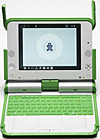What happens when the $100 laptop actually gets used?
“Clearly, children love the machine. Most of them had never seen a computer before and the great design of the laptop was compelling. They are learning about technology even as they play. But why do they like it? By far, the most used function of the one laptop designed specifically for the world’s poorest children is taking pictures. The webcam–taking pictures and sharing them with friends–is the most discussed computer function. That’s cool and great, but is it the highest priority for ‘education?'”
Then there is the cost. I personally hadn’t added up all the money that goes into the $100″ laptop. What, in fact, is the true bottom line cost of the OLPC? Will governments that accept the OLPC subsidize the operating cost–electricity, repairs, etc.?
Finally, there is the actual teaching. The laptops in Nigeria came with pre-loaded learning programs. The BBC story doesn’t say who wrote these lessons and where they came from. The teachers appear to like them and perhaps that is enough. But is it? Were the lessons written by teachers in Nigeria? Would you accept lesson plans from another country for your kids?”
The project clearly suffers from a top-down approach, where “designing for” is the paradigm rather than “designing with” or “designing from”. There was as far as I know no structured needs analysis here, no contextual studies, no ethnography, no qualitative insights. Such an approach cannot lead to anything but unintended consequences and may be potentially undermining the project itself. There are many lessons to be learned here, by the OLPC (“one laptop per child”) team, but also by any company or organisation trying to deliver designed solutions for “end-users” who then turn out to have different needs and contexts that had somehow been anticipated.
But of course, we can always blame those “end-users” instead of learning some important lessons, and I am afraid this is definitely going to be part of the debate that will undoubtedly ensue.





[…] This blog post has some thought-proviking (but unfavorable) commentary about the design process behind the laptop and links to more favorable reviews of the device itself. For example, this one from the BBC which claims “the children [in a Nigerian pilot study] – most of whom had never seen a computer before March – have clearly embraced the green and white machines.” […]
[…] is of course right and it reminds me of my own comments half a year ago: “The project clearly suffers from a top-down approach, where […]